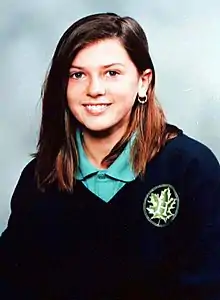Murder of Billie-Jo Jenkins
Billie-Jo Margaret Jenkins (29 March 1983 – 15 February 1997)[1] was an English girl who was murdered in Hastings, East Sussex in February 1997. The case gained widespread media attention and remains unsolved.
Billie Jo Jenkins | |
|---|---|
| Born | 29 March 1983 East London, England |
| Died | 15 February 1997 (13) Hastings, East Sussex, England |
| Cause of death | Murder |

Background
Billie-Jo Jenkins was brought up in East London. Her father was imprisoned and her mother was unable to cope on her own, so Jenkins was placed in foster care from the age of nine with Siôn and Lois Jenkins, who coincidentally had the same surname as her. She moved with the family to Hastings on the East Sussex coast, where she attended Helenswood School.
On 15 February 1997, she was beaten to death at the family home. Siôn Jenkins was subsequently charged with murder and stood trial and was convicted, whilst maintaining his innocence. An appeal in 1999 against his conviction failed, but after a second appeal in August 2004 it was quashed by a court as unsafe and he was released on bail pending a retrial. The juries in two retrials were unable to reach verdicts, and a 'Not Guilty' verdict was returned by a court in 2006.
Legal proceedings against Siôn Jenkins
On 15 February 1997, the body of 13-year-old Billie-Jo Jenkins was found in the back garden of the family home in Hastings, East Sussex. She had been battered over the head with an iron tent peg whilst painting the patio doors alone; the rest of the family had reportedly been away from the property at the time. An unnamed local man was arrested on suspicion of murder soon afterwards, but then released from police custody and detained under the Mental Health Act. On 24 February, her foster father Sion Jenkins was arrested on suspicion of murder.[2] He was charged with murder on 14 March.[3]
Siôn Jenkins told police that he found Billie-Jo in a pool of blood on the patio when he returned from a shopping trip with two of his daughters, Annie and Charlotte ("Lottie"). He became the third police suspect following a police investigation which revealed erratic behaviour by him around the time of the incident, supported by the discovery of 158 microscopic blood spots on his clothing.
After a trial by jury he was convicted on 2 July 1998 of the murder of Jenkins and sentenced to life imprisonment.[4]
Investigative journalist Bob Woffinden believed that it was a miscarriage of justice.[5] An appeal in 1999 failed, but in May 2003 following a two-year investigation by the Criminal Cases Review Commission, his case was referred back to the Court of Appeal. The basis for the referral outlined in the Commission's Statement of Reasons was that: "There is evidence, not before the jury, that suggests Mr Jenkins could not have committed the murder".[6] The second appeal in August 2004 was successful and the Court of Appeal quashed his original conviction as unsafe and ordered a retrial, with Jenkins being released on bail.
At the retrial, forensic scientists stated that the microscopic blood spray could conceivably have been released from Billie Jo's injured airway as Jenkins moved her. The jury was unable to come to a majority verdict after 39 hours of deliberating. A second retrial was likewise unable to reach a majority verdict, and at the Old Bailey in London, on 9 February 2006, Siôn Jenkins was declared in consequence not guilty. The Crown Prosecution Service indicated that no further retrials of Jenkins would be sought, and he was formally acquitted.[7]
The police investigation, trials and appeals are estimated to have cost £10m. Seven hundred witness statements were taken by the police, and jurors spent 36 days deliberating in three trials. Jenkins spent 11 days in the witness box giving evidence.[8]
In 2010, the British Government refused an application from Jenkins for financial compensation for his imprisonment.
Other potential suspects
Around the time of the murder, a mentally ill man was seen in the street and area. He was taken into custody, but considered to be unable to be questioned. Jenkins said that he and his wife Lois were "so worried about prowlers and break-ins in the area where they lived that they had security lights and window locks fitted to their home".[9]
Memorial seat
On 19 January 2008, in Alexandra Park, Hastings, a memorial seat made from a locally felled oak tree by local artist Joc Hare, was dedicated to the memory of Billie-Jo. The first few words on the seat read, "Side by side or miles apart, friends are close to the heart".[10]
There is also a memorial seat at Hermit Road Recreation Ground, in East London, opposite the West Ham cemetery, inside the Daisy Parsons Memorial Garden.
References
- England & Wales, Civil Registration Death Index, 1916–2007
- "Sion Jenkins: A father betrayed?". The Independent. 24 August 2008.
- "Justice for Siôn Jenkins - Timeline". Justiceforsionjenkins.org.uk. Retrieved 10 March 2020.
- "Sion Jenkins convicted of Billie-Jo murder". BBC News. 2 July 1998.
- "Wrong again: Siôn Jenkins is innocent" by Bob Woffinden, New Statesman, 11 July 1998 Archived 26 September 2015 at the Wayback Machine
- Statement of Reasons: CCRC Ref: 00226/2001/Jenkins
- Jenkins cleared in Billie-Jo case, BBC News, 9 February 2006
- "Allegations cost foster father his family and career" by Sandra Laville and Laura Smith, The Guardian, 10 February 2006
- Gray, Sadie (9 February 2006). "Profile: the contradictions of Sion Jenkins". timesonline.co.uk. London. Retrieved 27 December 2010.
- Friends unveil Billie-Jo memorial
External links
- Justice for Siôn Jenkins, a website that was set up to campaign for his release
- Gray, Sadie (9 February 2006). "Profile: the contradictions of Siôn Jenkins". Times Online. London. Retrieved 9 February 2006.
- Billie-Jo Jenkins at Find a Grave